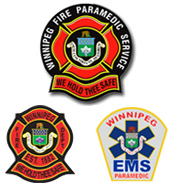Hot Works
Every year, hot works is among the top five causes of fires and explosions in North America. From 1989 to 1998, hot works fires were responsible for 21% of these fires resulting in over 100 billion dollars U.S. in insurance losses, untold thousands of jobs, and interrupted operations. Subcontractors such as plumbers, heating contractors, welding contractors, and roofing contractors (to name a few) consistently caused well over half of these completely preventable fires! The information in this brochure is provided to help ensure compliance to Section 5.2 of the Manitoba Fire Code. It is also provided to reduce or eliminate the occurrence of hot works fires occurring annually within the City of Winnipeg and to ensure that proper loss prevention procedures are in place prior to the commencement of any hot works.
Introduction
Generally speaking, hot works may be described as any process or operation involving open flames, heat production, or sparks. Some examples are cutting, welding, soldering, brazing, grinding, thermal spraying, and cutting or thawing of pipes.
Hot Works Equipment
Many fires involving hot works are due to failure to maintain equipment in good operating condition. All hot works equipment should be examined for leakage or defects prior to each use. Any detected leakage or defects must be repaired prior to use. All valves should be closed and gas lines bled when Class 2 hot works equipment is not in use. Also, electric hot works equipment should be de-energized when not in use.
Compressed Gas Equipment
The design and installation of oxygen-fuel gas equipment must conform to NFPA 51: "Design and Installation of Oxygen-Fuel Gas Systems for Welding, Cutting, and Allied Processes". Unalloyed copper piping is not allowed to be used for acetylene gas. Oil or grease cannot be used with the equipment for oxygen.
Locations of Hot Works
Hot works should be carried out in areas free of combustible and flammable materials. Walls, ceilings, and floors should be made of non-combustible construction or lined with non-combustible materials. All flammable and combustible materials within 15 meters of the hot works must be protected against ignition. Combustible materials or building surfaces that cannot be removed or protected should be thoroughly wetted to prevent ignition. Since there is a possibility of sparks leaking onto combustible materials in adjacent areas to the hot works in progress, all openings in walls, floors, or ceilings must be covered or closed.
Work on Piping, Equipment, or Containers
Hot works shall not be performed on containers, equipment, piping containing combustible, or flammable liquids or gases unless they have been cleaned and tested with a gas detector to ascertain that they are free of explosive vapours.
Fire Watch
A fire watch must be provided during the hot works and for a period of no less than 60 minutes after its completion. A final inspection of the hot works area must be conducted four hours after completion of the work. At least one portable fire extinguisher must be situated in the hot works area and the fire watch personnel must be trained in the use of fire extinguishing equipment. All previously covered openings in walls, floors, and ceilings should be examined for ignition of combustible materials.
Additional Measures
To reduce or eliminate the possibility of nuisance or "false alarms", temporarily cover sprinklers in the immediate vicinity with noncombustible material or damp cloths. Smoke detectors in the affected area may be temporarily "zoned off" or "bagged" to avoid activation and so as to maintain maximum protection for the duration of the hot works. Remember to remove the temporary protection when the hot works operation is completed!
Gas Cylinder and Equipment Precautions
Remember to check all hoses for cracks, leaks, and defects and make repairs prior to the onset of work. Ensure that gas cylinders are never stored where they may be exposed to physical or mechanical damage or tampering. Cylinders should be stored where they will not be in danger of being knocked over or impede passage of workers, equipment, or industrial trucks. They must be chained or otherwise restrained to prevent them from falling over.
Hot Works Brochure
Sample Hot Works Permit
Last update:
July 27, 2017


